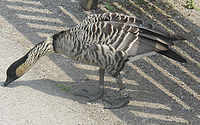
Nene (bird)
Background Information
This wikipedia selection has been chosen by volunteers helping SOS Children from Wikipedia for this Wikipedia Selection for schools. Click here for more information on SOS Children.
| Hawaiian Goose | |
|---|---|
 |
|
| Conservation status | |
|
Vulnerable ( IUCN 3.1) |
|
| Scientific classification | |
| Kingdom: | Animalia |
| Phylum: | Chordata |
| Class: | Aves |
| Order: | Anseriformes |
| Family: | Anatidae |
| Genus: | Branta |
| Species: | B. sandvicensis |
| Binomial name | |
| Branta sandvicensis ( Vigors, 1833) |
|
The Hawaiian Goose or Nēnē, Branta sandvicensis, is a species of goose endemic to the Hawaiian Islands. It shares a recent common ancestor with Branta canadensis, the Canada Goose. The official bird of the State of Hawaiʻi, the Nēnē is exclusively found in the wild of the islands of Maui, Kauaʻi and Hawaiʻi. A larger, extinct and possibly flightless species, the Nēnē-nui (Branta hylobadistes), was present in prehistoric times on Maui; related, but hitherto undescribed forms also occurred on Kauaʻi and Oʻahu; there was also a gigantic, flightless relative on the island of Hawaiʻi.
The Nēnē gets its Hawaiian name from its soft call.
The adult male has a black head and hindneck, buff cheeks and heavily furrowed neck. The neck has black and white diagonal stripes. The female Hawaiian Goose is similar to the male in coloring but slightly smaller. The adult's bill, legs and feet are black. The young birds are similar to the male, but are a duller brown and with less demarcation between the colors of the head and neck, and striping and barring effects are much reduced. The bill, legs and feet are the same as for the adult.
Its strong toes have much reduced webbing, an adaptation to the lava flows on which it breeds. It mates on land unlike most other wildfowl.
This is the world's rarest goose. The bird was once believed to be common, with approximately 25,000 nenes living in Hawai'i when Captain James Cook arrived in 1778. However, hunting and introduced predators such as mongooses, pigs, and cats reduced the population to 30 birds by 1952. However, this species breeds well in captivity, and has been successfully re-introduced; in 2004 it was estimated that there were 800 birds in the wild, as well as 1000 in wildfowl collections and zoos. However, there is some concern of inbreeding due to the small initial population of birds. The nature reserve WWT Slimbridge in England was instrumental in the successful breeding of Nēnē geese in captivity. Under the direction of the leading conservationist Sir Peter Scott, it was bred back from the brink of extinction during the 1950s for later re-introduction into the wild in Hawaii. There are still nēnē geese at Slimbridge today.
